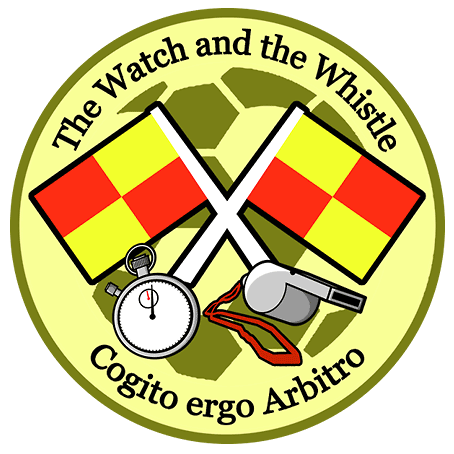Circumstances, Mechanics, and Aftermath
Laws and Mechanics
In this chapter I enumerate the starts, restarts, and stops
during the game. It is all fairly mechanical, but some of
the restarts (Direct and Indirect Free Kicks) are due to offsides,
fouls, and misconduct -- tricky issues which have their own
chapters.
For each event I describe the circumstances which lead to
it, the mechanics for orchestrating it, and what is likely
to happen thereafter.
The Starts
-
-
The Kick Off
-
-
Circumstances
-
At the beginning of the game, at the beginning of the
2nd half, and after a goal there is a Kick Off from the
center circle.
-
Mechanics
-
Stand outside the center circle on the halfway line.
Ensure that:
-
a) All players are in their respective halves of the field.
-
b) All defenders are outside the center circle (10 yards away).
-
c) All players look more or less ready.
-
d) The ARs acknowledge your eye contact.
Point your arm up in the direction of the kick and blow your
whistle.
The ball is in play when it is kicked and clearly moves.
-
Mechanics for the ARs
-
The ARs position themselves to judge offside, level to the
2nd-to-last defender. If this is the beginning of a
half, they are supposed to unfurl their flags and make
eye contact with the center referee to indicate their
readiness.
-
What's Next
-
If players aren't in their halves of the field or
defenders move into the center circle before the kick, then
the kick is retaken.
If the kicker plays the ball a second time before anyone
contacts the ball, the other team gets an Indirect Free
Kick, described below.
A team can score directly from a Kick Off, in case you
are wondering.
The Restarts
-
-
The Throw-In
-
-
Circumstances
-
If one team sends the ball wholly over the touch line,
you're going to award a "Throw-In" to their opponents.
You get to judge which side last touched the ball. This is the
call most often blown, but it doesn't matter all that much
in the grand scheme. The main purpose is to put the ball
back into play, so all you have to do is sell your decision.
Since the Throw-In is one of the most common restarts,
it is one of the easiest ways to earn or lose your authority.
-
Mechanics
-
Often it is the AR that judges the ball to be out of bounds,
so frequent glances at the AR are important when the ball is
at the edge of the field. But either you or the AR can make
the determination. Eye contact with the AR is important when
signaling, to settle any doubt and make sure you are in
agreement over who gets the throw.
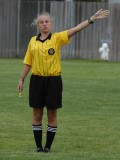 Stop running, stand still facing the touch line the ball passed
over, and point your rigid arm up in the direction the opponents
are going. Use the appropriate arm. You can also call out the
color of the team that gets the ball.
Stop running, stand still facing the touch line the ball passed
over, and point your rigid arm up in the direction the opponents
are going. Use the appropriate arm. You can also call out the
color of the team that gets the ball.
If you and the AR disagree, you can negotiate with glances
or words, but you have the final vote, and both of you
should point in the same direction by the time the Throw-In
takes place.
Position yourself for the action likely to result from the
Throw-In.
-
Mechanics for the AR
-
To signal a Throw-In the AR stops running, changes arms if
needed, and points the flag up at a 45 degree angle in the
proper direction.
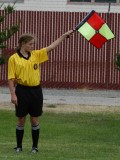 If the ball went out of bounds and came back in, then the AR
first holds the flag straight up (in the appropriate arm)
until the center referee whistles, and then signals for the
Throw-In. It is important to practice this flag-up first
on Throw-Ins because it is the same for other, subtler calls
(like Corner Kicks and goals).
If the ball went out of bounds and came back in, then the AR
first holds the flag straight up (in the appropriate arm)
until the center referee whistles, and then signals for the
Throw-In. It is important to practice this flag-up first
on Throw-Ins because it is the same for other, subtler calls
(like Corner Kicks and goals).
For the Throw-In the AR resumes position to judge offside.
Sometimes this means backing up off the touch line to make
room for the thrower.
-
What's Next
-
-
Rethrow:
-
If the thrown ball never comes into play (i.e. never
touches the vertical plane at the outside edge of the
touch line), the throw is retaken.
-
Throw for other team:
-
A Throw-In is supposed to happen within one yard of
where the ball went out, but it almost never does.
If they are gaining some advantage you can whistle them
back and point to the proper location. If it is clear
they are working the system give the other team the throw.
A legal Throw-In has both of the thrower's feet on the
ground, with any part of the feet touching or outside the
touch lines, until the ball leaves his hands. He has to
throw with both hands starting from behind the head and
going over the head.
The most common mistake is to lift the back foot up
before the ball is out of the hands. Younger players
will sometimes jump up with both feet. Good players will
drag their back foot up as they throw, which is legal.
Rarely players will start the throw from over the line;
sometimes they'll end up over it: throw for other team.
Sometimes players will start the throw from overhead (rather
than behind), bring it around the side, or stop and start
throwing several times. Unless it is a complete throw
from behind and over the head, the other team will get the
throw.
If the ball comes into play but then curves back out,
the other team gets the throw.
-
Indirect Free Kick:
-
No 2nd touch or keeper handling: if the thrower is
the first to play the ball, or the player's keeper is
the first and he picks it up, the other team gets an
Indirect Free Kick.
-
Goal Kick, Corner Kick:
-
No scoring from Throw-In: if the ball goes directly
in the goal it's either a Corner Kick (it went in the
throwing team's goal) or a Goal Kick (it went in the
opponents' goal).
-
Yellow Card:
-
Opponents must retreat two yards from the thrower so as
not to impede the throw. Being a nuisance in
this regard falls under Unsporting Behavior, a cautionable
offense. If the Throw-In was taken it's an Indirect Free
Kick for the throwing team, not a re-throw.
-
The Goal Kick
-
-
Circumstance
-
If the attackers send the ball wholly over the goal line
(but not into the goal), you're going to award a "Goal Kick"
to the defenders. That's where they place the ball somewhere
inside the goal area lines (usually on the goal area line,
to get as far from the goal as possible) and kick it clear
of the penalty area.
-
Mechanics
-
As with Throw-Ins, often it is the AR that judges the ball to
be out of bounds, so frequent glances at the AR and eye contact
when signaling are important.
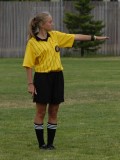 Point your arm flat or a slight angle down into the middle of
the goal area. You can call "Goal Kick."
Point your arm flat or a slight angle down into the middle of
the goal area. You can call "Goal Kick."
Position yourself downfield in anticipation of the kick.
This is a good time to run backwards (being careful not to
back over small players).
-
Mechanics for the AR
-
To signal a Goal Kick the AR points the flag flat
across the field towards the middle of the goal area.
Because the AR should be following the ball to the goal, his
signal should from near the goal line.
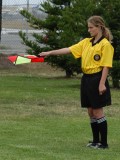 If the ball went out of bounds and came back in, then the AR
first holds the flag straight up until the center referee
whistles, and then signals for the Goal Kick.
If the ball went out of bounds and came back in, then the AR
first holds the flag straight up until the center referee
whistles, and then signals for the Goal Kick.
For the kick the AR positions himself in the position to judge
offside.
-
What's Next
-
-
Retake:
-
A legal Goal Kick starts with the ball stationary within the
goal area with all opponents outside the penalty area or
moving that way. If the kick is taken outside
the goal area or the ball is moving, the kick is retaken.
If there are opponents in the penalty area, the kicker doesn't
have to wait for them to leave.
The ball is in play when it is kicked and clearly moved.
-
Indirect Free Kick:
-
No 2nd touch or keeper handling: if the kicker is the
first to play the ball or the player's keeper is the first
and he picks it up, the other team gets an Indirect Free Kick.
-
Corner Kick:
-
If the ball is kicked backwards across the goal line,
even if into the goal, it's an Corner Kick for the other team.
You can't score against yourself on a Goal Kick.
-
Goal, Goal Kick, Throw-In:
-
The ball is in play once it is kicked and clearly moves,
so if it goes out of bounds a normal restart occurs.
You can score on an opponent from a Goal Kick.
-
The Corner Kick
-
-
Circumstance
-
If the defenders send the ball wholly over the goal line
(but not into the goal), you're going to award a "Corner
Kick" to the attackers. That's where they place the ball
in the corner arc of the nearer corner and kick it.
The ball is in play once it is kicked and clearly moves.
-
Mechanics
-
As with Throw-Ins, often it is the AR that judges the ball to
be out of bounds, so frequent glances at the AR and eye contact
when signaling are important.
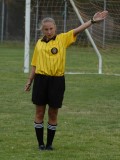 Point your arm up 45 degrees at the corner where the kick is
to be taken (the one closest to where the ball went over the
goal ine). You can call "Corner Kick."
Point your arm up 45 degrees at the corner where the kick is
to be taken (the one closest to where the ball went over the
goal ine). You can call "Corner Kick."
Position yourself somewhere around the corner of the penalty
area. It's more important to watch the players receiving the
kick than the one taking the kick, as the players may foul each
other vying for that important ball. If you choose a different
vantage point each time, you can discourage "set" fouls.
-
Mechanics for the AR
-
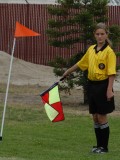 To signal a Corner Kick the AR points the flag down 45 degrees
along the touch line in the direction of the corner. Because
the AR should be following the ball to the goal, he should be
standing next to the flag by this time.
To signal a Corner Kick the AR points the flag down 45 degrees
along the touch line in the direction of the corner. Because
the AR should be following the ball to the goal, he should be
standing next to the flag by this time.
If the ball went out of bounds and came back in, then the AR
first holds the flag straight up until the center referee
whistles, and then signals for the Corner Kick.
For the kick the AR positions himself to judge out of bounds:
in line with the goal line behind the flag and kicker.
-
What's Next
-
-
Retake:
-
A legal Corner Kick starts with the ball in the corner arc,
standing still, and with all opponents at least 10 yards
away from the arc until the kick. If any of these are wrong,
the kick is retaken. The 10 yard rule can be waived if the
kick scores.
-
Indirect Free Kick:
-
No 2nd touch or keeper handling: if the kicker is the
first to play the ball, or the player's keeper is somehow
the first (all the way at the other end of the field) and
he picks it up, the other team gets an Indirect Free Kick.
-
Goal:
-
You can score from a Corner Kick.
-
Direct and Indirect Free Kick
-
-
Circumstances
-
If a player commits a Direct Free Kick (DFK) foul outside
of his own penalty area, you are going to award a Direct
Free Kick to the other team. If a player commits an
Indirect Free Kick (IFK) foul, or is penalized for being
offside, you are going to award an Indirect Free Kick
to the other team.
In both cases, the kicking team is given an opportunity,
"free" from defensive interference, to kick the ball from
a standstill. The only difference between the direct and
Indirect Free Kicks is that a goal can't be scored directly
from an Indirect Free Kick -- it must touch another player
first.
Anyone can take the kick, not just the player fouled against.
Calling Direct Free Kick fouls, Indirect Free Kick fouls,
and offside is discussed in their own sections. Here I'll
just cite the mechanics for the kick itself.
-
Mechanics
-
Depending on the severity of the foul, blow your whistle
either one medium or long blast.
To signal for a Direct Free Kick, point one hand up
in the direction of the kick. For an Indirect Free Kick,
do the same but then hold your arm straight up to indicate
a goal cannot be scored directly. For offside calls, you
can usually just go from the whistle to the straight up arm,
since everyone knows who's at fault.
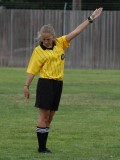 The restart takes place where the infringement occurred, not
necessarily where the infringer or ball were. You can either
point to the location with your free hand, or you can move
to the location and stand there until the ball arrives, or
you can just let the players take care of it. Exact positioning
becomes more important as the restart gets closer to the
defenders' goal.
The restart takes place where the infringement occurred, not
necessarily where the infringer or ball were. You can either
point to the location with your free hand, or you can move
to the location and stand there until the ball arrives, or
you can just let the players take care of it. Exact positioning
becomes more important as the restart gets closer to the
defenders' goal.
A free kick inside the kicker's goal area can be taken
anywhere inside the goal area, just as with a Goal Kick.
An Indirect Free Kick against the defense inside the their
goal area gets moved to the nearest spot on the goal area
line parallel to the goal line. This is important.
There are two varieties of free kicks: quick and ceremonial.
Most kicks are quick: the kick can be made as soon as you
signal with your arm, which should be right after your
whistle. This discourages fouls that provide time for the
fouling team to assemble its defenses.
A quick kick can turn into a ceremonial kick if the kicker
asks you for "10 yards." That means he wants the defenders to
retreat. Tell the kicker to wait for your whistle, and point
to the whistle so that everyone sees. Before you restart, wait
for the defenders to move 10 yards away from the ball -- in all
directions, actually, but most people worry most about the
direction of the kick.
A quick kick can turn ceremonial if you want to stop play
to warn, caution or send off a player. You'll often blow the
whistle a second time to make this clear. You can then tend to
business before positioning yourself for the restart.
If the quick kick happens before you're able to stop it
you are allowed to delay discipline until the next stoppage.
For a cefermonial kick, position yourself down in the direction
of the kick. You'll start again with a whistle.
For an Indirect Free Kick, you need to hold your arm straight
up to indicate that a goal cannot be scored directly from the
kick. You can lower it while positioning yourself for the
kick. After the kick you lower your arm once the ball touches
another player, goes out of bounds, or if it isn't kicked
towards either goal .
-
More Mechanics -- Managing the Wall
-
For the taking of a free kick near the goal
defenders may line up 10 yards away in a "wall".
If more than three defensive players form a wall, any attackers
must be at least one yard away. Since the wall often determines
the offside position, the attackers will likely be to the side
or next to the wall.
For the kick position yourself so you can pay attention to the
wall. If there are no attackers near the wall, you can instead
head towards the goal to watch the excitement there.
-
Mechanics for the AR
-
The AR does not signal for fouls handled by the center
referee in distant parts of the field.
The AR does signal for fouls that are nearer to him than
to the center referee -- generally any foul in the corner of
the field the AR tends. For fouls seen by the center referee,
the AR's signal is there to reinforce the center's. The AR
also signals for serious fouls in other parts of the field
that are unseen by the center referee.
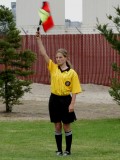 To signal a foul the AR holds his flag straight up. Once the
center referee notices, the AR makes quick, small waves with
the flag, then signals the direction of the kick by pointing
the flag up 45 degrees along the touchline in the direction
of the kick. There's no official way for an AR to indicate
an Indirect Free Kick, though some do so by holding the free
arm up halfway or by simply saying "indirect."
To signal a foul the AR holds his flag straight up. Once the
center referee notices, the AR makes quick, small waves with
the flag, then signals the direction of the kick by pointing
the flag up 45 degrees along the touchline in the direction
of the kick. There's no official way for an AR to indicate
an Indirect Free Kick, though some do so by holding the free
arm up halfway or by simply saying "indirect."
At the taking of a free kick, the AR assumes the position
to judge offside.
-
What's Next
-
-
Retake:
-
A legal free kick starts with the ball standing still at
(about) the point you indicate. If any of these are
wrong, the kick is retaken.
-
Indirect Free Kick:
-
No 2nd touch or keeper handling: if the kicker is the
first to play the ball, or the player's keeper is the
first and he picks it up, the other team gets an Indirect
Kick.
Note that many teams practice a maneuver for Indirect
Kicks where one player steps on the ball to make first
contact and then a second player kicks it.
The first contact must clearly move the ball for it put
the ball in play, otherwise it is the subsequent kick
that does so.
-
Goal:
-
You can score from a Direct Free Kick.
-
Goal Kick:
-
You can't score directly from an Indirect Free Kick, so if
the ball goes directly into the opponent's goal, it is
a Goal Kick for them.
-
Corner Kick:
-
You can't score directly against yourself on either a
Direct or Indirect Free Kick, so if the ball goes directly
into the kicker's goal, it's a Corner Kick.
-
Yellow Card
-
Whether it is a quick kick or a ceremonial one, defenders
are supposed to retreat 10 yards in all directions.
Failing to do so is its own cautionable offense, as I
discuss in the "Misconduct" section below.
-
Penalty Kick
-
-
Circumstances
-
If a player commits a Direct Free Kick foul inside of his own
penalty area, you are going to award a Penalty Kick to the other
team. This is a highly ritualized punishment involving only the
kicker and the goal keeper, with something like a 90% chance
of scoring.
Anyone can take the kick, not just the player fouled against.
Calling Direct Free Kick fouls is discussed in its own section.
Here I'll just cite the mechanics for the kick itself.
-
Mechanics
-
As with a Direct Free Kick, blow your whistle.
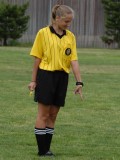 Point with your finger distinctly towards the penalty mark,
halfway between the goal area line and the penalty area line.
You don't want to be mistaken on this. Prepare for both
groans and cheers from the sideline.
Point with your finger distinctly towards the penalty mark,
halfway between the goal area line and the penalty area line.
You don't want to be mistaken on this. Prepare for both
groans and cheers from the sideline.
Stand at the penalty mark until the kicker places the ball
there, or if you prefer collect the ball and hand it to the
kicker. Instruct the kicker to wait for your signal.
Ensure that all players other than the kicker and the
keeper are
-
(a) outside of the penalty area,
-
(b) behind the penalty mark (farther from the goal line),
and
-
(c) outside of the penalty arc and thus 10 yards from
the kicker.
Ensure the keeper is on the goal line between the goal posts,
facing the field. He will need to keep at least one
foot on the line until the ball is kicked.
Move off to the side of the kicker, about 10 yards, and
blow your whistle. Play can get very active at this point.
-
Special Mechanics for Extra Time
-
If time expires (or will expire) before the Penalty Kick is
taken, you need to announce that the kick will be in extra
time. Players may retreat since there is nothing they can do.
The ball is out of play if the keeper successfully stops or
deflects the ball. The kicker may not play it again, even if
it rebounds.
-
Mechanics for the AR
-
The AR signals for a Penalty Kick if a defender commits a foul
in the penalty area that the AR notices. For fouls seen by
the center referee, the AR can signal to confirm that the foul
was committed in the penalty area.
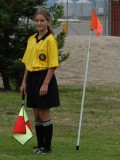 To signal a Penalty Kick the AR holds his flag straight up.
Once the center referee notices, the AR makes quick, small
waves with the flag and then goes to stand in front of the
corner flag on the goal line to indicate a Penalty Kick.
To signal a Penalty Kick the AR holds his flag straight up.
Once the center referee notices, the AR makes quick, small
waves with the flag and then goes to stand in front of the
corner flag on the goal line to indicate a Penalty Kick.
To confirm that a foul seen by the CR was inside the penalty
area, if the CR seems to be in doubt, the AR holds the flag
horizontally across his waist.
At the taking of a Penalty Kick, the AR's mechanics are left
up to the CR. Here's a common approach: the AR stands on the
goal line at the penalty area line, so as to judge the goal,
keeper encroachment, and later offside. To indicate keeper
encroachment or other problems, the AR holds the flag
horizontally across his waist. Goals are indicated as
described below in the "Stops" section. If play is to continue,
the AR hustles back to the touch line, cutting the corner if
needed.
The CR and ARs should verify Penalty Kick mechanics at pre-game.
-
What's Next
-
-
Retake:
-
A legal Penalty Kick happens only on your signal that
you are ready. Use the whistle.
The keeper must keep at least one foot
on the goal line and all other players must not encroach
until the kick happens.
The kick is retaken if (a) the ball doesn't enter
the goal defending team encroached or (b) the ball
enters the goal and the attacking team (or both
teams) encroached. i.e. cheaters never prosper.
If it's the keeper's encroachment that causes
the retake, he is also cautioned for Unsporting
Behavior.
-
Indirect Free Kick:
-
No 2nd touch: if the kicker is the first to play the
ball the other team gets an Indirect Free Kick. This
includes if the ball bounces off the goalpost back to
the kicker.
Attacker encroachment: if the attacking team encroaches
and the ball doesn't go in the goal, it's an Indirect
Kick at the penalty mark. (Retake if it does go in.)
Attacker infringement: the attacking team can
occassionally bungle the Penalty Kick in numerous
ways that give the defending team an Indirect Free Kick
at the point of infringement. By the kicker kicking
the ball backwards, by the kicker illegally feinting
(fully stopping during the run-up to the kick), and
by someone other than the designated kicker taking
the kick.
Both illegal feinting and the wrong kicker
taking the kick warrant a caution for Unsporting
Behavior.
-
Goal, Goal Kick, Corner Kick, Throw-In:
-
The ball is in play once it is kicked forward and
so if it goes out of bounds a normal restart occurs.
You can score from a Penalty Kick.
-
The Dropped Ball
-
-
Circumstance
-
If you need to restart play and none of the other restarts
apply, you'll do a Dropped Ball. This is the only time
you need touch the ball during play. The most likely causes are:
-
a) Stop for an injury
-
b) Stop for interference
-
c) Stop to control the sidelines
-
d) Stop when the ball hits the referee and it changes play
too dramatically, by creating a promising attack or clearly
changing possession.
Note that you don't do a Dropped Ball when you can't decide who
kicked the ball out of bounds: for that, you just have to
make a choice.
-
Mechanics
-
Announce that you're doing a Dropped Ball.
If the ball was in the penalty area or last touched in the
penalty area, you'll do a Dropped Ball for the defending keeper
in the penalty area. Otherwise, you'll do a Dropped Ball for a
player of the team that last touched it where it was last touched.
Ensure no other players are within 4 yards (meters actually).
Drop (don't throw) the ball in front of the player.
The ball is in play when it hits the ground. Unlike all other
restarts, the first player to touch the ball is free to touch
it again, but like an Indirect Free Kick a goal cannot be scored
on the first touch.
-
Mechanics for the AR
-
The AR does nothing special for a Dropped Ball.
-
What's Next
-
-
Retake:
-
If the ball is played before it hits the ground, or it
rolls out of bounds or into the goal without a player
touching it, you'll retake the Dropped Ball.
-
Goal Kick:
-
If the ball is kicked directly by a player into the
opponents' goal from a Dropped Ball, you restart with a
Goal Kick. As soon as anyone touches the ball again, it's
fair game.
The Stops
-
-
Goal!
-
-
Circumstance
-
If the whole of the ball goes over the goal line, between
the goal posts and below the crossbar, and neither you
nor the AR consider play to have stopped before it does,
it's a goal. (Remember: you can decide after the fact
that play had stopped, like when you notice the AR
signaling offside only after the ball goes in the goal.)
-
Mechanics
-
If you see the ball go in the goal, or think it might
have, look at your AR. He indicates or confirms a goal
by, after making eye contact, sprinting towards the
halfway line.
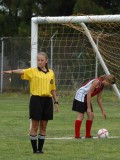 Point your arm level at the center circle -- the location
of the next kick -- and move to the position for the
next Kick Off. If the players are likely to complain
about the goal, move quickly. If the players are likely
to start a melee over the goal, run backwards towards the
halfway line so that you can watch activity around the goal.
Point your arm level at the center circle -- the location
of the next kick -- and move to the position for the
next Kick Off. If the players are likely to complain
about the goal, move quickly. If the players are likely
to start a melee over the goal, run backwards towards the
halfway line so that you can watch activity around the goal.
While waiting for the players to reassemble, take out
the game card and note the goal -- either with a simple
strike or (if you have your own note paper) with the
player and time as well.
-
Mechanics for the AR
-
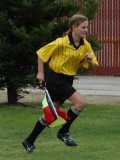 If the center referee sees the ball go in the goal, he
looks to the AR for confirmation, which the AR then
provides by sprinting up the touch line towards the
halfway line -- enough of a sprint to be obvious -- and
then positioning himself for the Kick Off.
If the center referee sees the ball go in the goal, he
looks to the AR for confirmation, which the AR then
provides by sprinting up the touch line towards the
halfway line -- enough of a sprint to be obvious -- and
then positioning himself for the Kick Off.
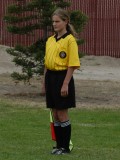 If what the center referee saw wasn't in fact a goal, the
AR can either be signaling something else -- such as a
corner/Goal Kick, offside, or a foul -- or do nothing,
indicating that the ball, while close to the goal, didn't
go in. The AR might also shake his head "no." The AR
then goes about his usual business.
If what the center referee saw wasn't in fact a goal, the
AR can either be signaling something else -- such as a
corner/Goal Kick, offside, or a foul -- or do nothing,
indicating that the ball, while close to the goal, didn't
go in. The AR might also shake his head "no." The AR
then goes about his usual business.
If the center referee appears not to see the goal (usually
because the ball went in and back out of the goal), the
AR will signal by raising the flag and, after the center
referee whistles, sprinting towards the halfway line.
-
Half Time/Game
-
-
Circumstances
-
At the end of the first half, or the end of the game,
you stop play.
Most referees won't stop unless the ball is in "neutral"
play. Neutral means different things to different referees,
but if the ball is sailing towards the net and you blow your
whistle, be prepared to run for the parking lot.
-
Mechanics
-
Watch your watch as you get down to the last few minutes,
and possibly count the last few seconds.
Blow your whistle (medium then long for half time, twice
medium then long for game) and point your arm towards
the center circle. You can say "half time" or "game."
Walk to the center circle to meet your ARs, and ensure
the game ball makes it back there as well. If it is
halftime, you want to take the game ball with you so
it doesn't get lost during the break.
-
Substitutions
-
Youth soccer generally permits unlimited substitutions, which
means players can be swapped in and out many times during the
course of the game. This can only happen with your approval
(which should not be unreasonably withheld), and generally only
at the following times:
-
1. A Kick Off
-
2. A Goal Kick
-
3. A Throw-In (sometimes only for the throwing team)
-
4. An injury: if play is stopped the injured player
and anyone else can be substituted.
Your competition may allow substitutions at other times, such as
any stoppage.
When a coach wants to substitute players, he's supposed to line
them up at the halfway line. Your ARs are then supposed to
signal the substitution at the next appropriate stoppage by
holding the flag horizontal above their heads (with one AR
mirroring the other if needed), until you see it. If you don't
have decent ARs you need to look to the halfway line at each
substitution opportunity to see if players are waiting. For
low-level play, where substitutions are numerous and players and
coaches undisciplined, you may just have to wait for the cry of
"sub! ref! sub!" from the coach.
Once the request is made, you need to ensure that play does not
restart, and then you signal for the substitution. That usually
involves a whistle, a hand up at the player about to make the restart,
and some indication to the coach to proceed with substituting.
When the substitution is complete, you must restart with the whistle.
Orchestrating clean substitutions will make your life easier and
earn you a modicum of respect. They are especially important for
mid- and high-level play. Two simple ingredients make them clean:
that players enter from the halfway line and that the
leaving happens before the entering. "Call them off" and "From
the midline" are the two instructions coaches seem to understand.
I usually optimize somewhat: as long as I can count the leaving
and entering players in the same view, I don't hold up the
entering players; and as soon as the entering players are moving
I let the restart begin. This keeps things moving.
Players are supposed to leave at the nearest boundary, which you
might want to enforce to prevent a long, slow walk by a player
from the winning team.
Decent ARs can help you with substitutions. If you expect this,
tell them so at pre-game.
Goalkeeper substitions work like any other, but be careful to note
any goalkeepr substitution at halftime. Coaches may or may not point
this out to you but you'll want ot keep track of number changes.
A goalkeeper and player can swap positions at any stoppage but only
with your permission (which shouldn't be unreasonbly withheld).
If they do it without your knowledge, they each get a caution for
Unsporting Behavior. But importantly: the player in the goalkeeper
jersey is the effective goalkeeper, whether they told you or not.
-
Injury
-
Referees are supposed to deal with major injury immediately, and
minor injury at the next normal stop in play. If play drags on,
you can stop play as soon as the ball is in somewhat neutral
territory. Don't stop an attacker's drive unless it is truly
necessary.
Seriousness of injury varies with age: with starting players,
I consider it serious enough if the player is either on the
ground, crying, or stunned and standing still. For intermediate
players, on the ground is my rule. For competitive players,
I really need to see the pain to stop play.
Do not tend or touch injured players! Run to them, find
out if the injury is serious and whether they wish to continue to
play. If it is serious, call out the coach and back off -- don't
let the coach harangue you.
If you stopped play to assess the injury, the injured player and
anyone else can be substituted. If you called the coach out, the
injured player must leave the field, unless the injury was
caused by a foul that warranted a caution or sendoff, or
if the injured player is about to take a penalty kick,
in which case the player can be tended to on the field. In matches
with unlimited substitutions, an injured player leaving the field
will most likely be substituted.
If you stopped play just to deal with an injury, restart with a
Dropped Ball.
If a team is playing short due to an injured player having left
the field without being substituted, the recovered player can,
with your permission, enter the field during the run of play.
-
Bleeding and Equipment Problems
-
A player bleeding or with blood on his clothes must leave the
field and may not return until the problem is corrected. If you
have to, you can stop play to ensure the player leaves, but
you can also just tell him on the fly. In theory, a bleeding
player needs your permission to leave and may not summarily walk
off, but once you realize what's going on your permission should
be implicit.
Similarly if a player has an equipment problem, such as a broken
shin guard or torn shirt, you can also send them off to deal
with their problems. This also applies to jewelery mysteriously
appearing after the initial checkin, for which you can be pretty
unforgiving.
In all these cases, the player may only come back with your
permission after you or your AR verify the problem has been
corrected. You can wave him on during the run of play, but he
must enter along the touch line and not the goal line.
-
Interference
-
Occasionally, there will be some outside entity that enters
the field and interferes with play: either by touching the ball,
getting the in way of players, or just in general being a
distraction on the field. Common examples are dogs, birds,
spectators, or a ball from a neighboring field.
There are a number of things that aren't interference: goal posts,
corner flags, referees (including assistants, if they are on
the field), or anything that was on the field at the beginning
of play. So if the ball bounces off a water bottle on the field,
play continues, unless the water bottle was thrown there after
the start of the game.
Special case: if the ball bursts during play, treat it exactly as
interference at that point.
To handle interference, blow your whistle to stop play and once
the interference has been addressed restart with a Dropped Ball.
If the interference occurs during the scoring of a goal,
but neither caused the goal nor prevented it, you can award the
goal.
-
Interference from Coaches, Substitutes, or Red Carded Players
-
Coaches, substitutes, and Red Carded players who come
on the field to interfere with play aren't treated as outside
interference. They're treated as if they were players committing
a foul.
The restart is a Direct Free Kick, or Penalty Kick if the
interference occurred in the defender's penalty area.
Additionally, you would send off a coach
or caution a substitute for entering the field
illegally. Not much you can do to an already sent
off player other than ask him to leave again.
If the interference occurs during the scoring of a goal for the
opponents, but neither caused the goal nor prevented it,
you can award the goal. You can still punish the perpetrator.
-
Yellow Card/Red Card
-
-
Circumstances
-
Bad fouls and misconduct often warrant cautions or send offs,
where you show the player the Yellow Card or Red Card.
I discuss the causes for cards in the "Misconduct" section.
Here I just describe the mechanics.
-
Mechanics
-
For fouls, stop play for the foul. For misconduct, you have
to decide whether it warrants stopping play or delaying until
the next normal stop to handle the misconduct. You run the
danger of things escalating if play continues for a while.
If it is serious enough to stop play, it warrants a good
loud whistle.
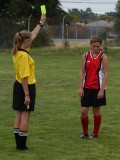 Remembering carefully in which pocket you have which card
pull the appropriate one out and stand about 5 feet from the
player, facing him. For the player's benefit you say, "You
are being cautioned for ..." or "You are being sent off for ...".
For the benefit of everyone else you hold the card with your
arm stretched overhead (not thrusting in the player's face).
Be sure you get a look at the player's number before he wanders
off.
Remembering carefully in which pocket you have which card
pull the appropriate one out and stand about 5 feet from the
player, facing him. For the player's benefit you say, "You
are being cautioned for ..." or "You are being sent off for ...".
For the benefit of everyone else you hold the card with your
arm stretched overhead (not thrusting in the player's face).
Be sure you get a look at the player's number before he wanders
off.
If a player receives a second Yellow Card he also gets
shown the Red Card and sent off. You do the two in succession,
not both in one hand.
You need to write on the game card the time, the player's
team and number, whether it was a Yellow Card or Red Card, and
the reason. Be sure you use one of the reasons enumerated
by the LOTG as discussed in the "Misconduct" section.
A player sent off is required to leave the immediate area.
To enforce this you shouldn't restart play until you are
convinced he is gone. This may not be practical in youth
games if there's no one to tend to the ejected player.
The restart after issuing a Yellow Card or Red Card is most
likely a Direct Free Kick or Penalty Kick, but there is
actually a laundry list of possibilities listed in the
"Misconduct" section.
Red Cards are serious business, and it is likely the sent
off player will be suspended for more than one game. To
that end, your league should have some set ritual for you
to follow within the next 24 hours to complete the paperwork.
Follow that procedure!
-
Terminating the Match
-
Your ultimate control over the game is the ability to terminate
the match. That's where you say, "I'm terminating the match" and
walk off with the game card. You might do so because you are unsure
or unsatisified with your ability to control the players, coaches,
or spectators. A perfect example of this is when an sent
off coach refuses to leave or when a team can no longer
field at least 7 players.
You can also abandon a match, sometimes to be played later,
because the condition of the field, light, or weather has
deteriorated to the point that play is no longer safe.
Lightning is a great reason to stop.
Back to Top
|
